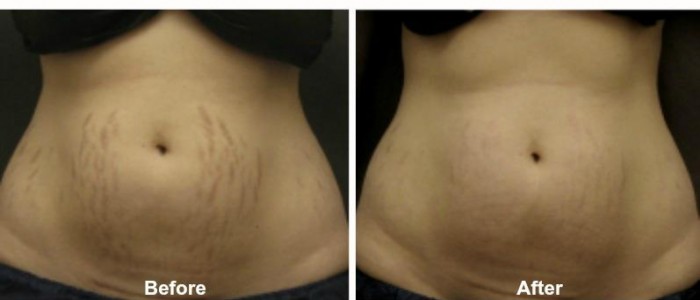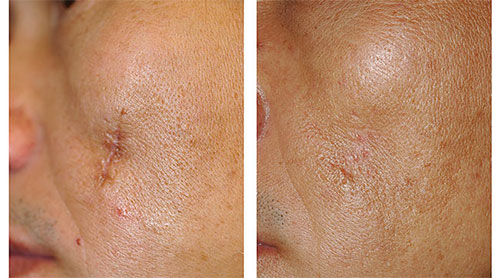Scars are the result of the body trying to heal itself after injury- be it after an accident, surgery, or in response to an inflammatory stimulus such as acne. In this section we will be discussing the different types of scars- macular, atrophic, hypertrophic and keloid– and stretch marks – and the different treatment options for each. The body’s response to injury is dependent on
- factors relating to the trauma itself – eg., a clean-cut sterile surgical wound vs a zig-zag or ragged wound with tissue necrosis resulting from an infected injury.
- host factors i.e. the body’s response– which could consist of hyperpigmentation, tethering or dimpling of the skin, neovascularization ie the growth of tiny new capillaries- giving the scar a pink appearance, or a hypertrophic reaction – i.e., tissue overgrowth, leading to a keloid scar
Scars can be flush with the skin surface- macular; beneath the skin surface atropic, or protrude above the skin surface –hypertropic, even extending beyond the incision or site of injury- Keloid. Immature scars are associated with redness from small blood vessels, and will fade to white as they mature. Inflammatory reactions following infection eg acne often result in changes in skin colour around the scar – hyperpigmentation– which is darkening of the skin; or loss of skin colour – hypopigmentation.
| Macular scars |
and hyperpigmentation can be addressed with chemical peels, bleaching agents in combination with IPL, or in some cases, laser resurfacing.

| Atropic scars |
are common following acne, and may be divided into icepick or boxcar scars. These are the easiest to deal with by laser resurfacing, and either non- ablative eg., Fraxel 1550 or ablative – fractional CO2 lasers – may be used . As a general rule, non- ablative lasers are associated with faster healing times, but are less effective and require more treatments than ablative lasers. Deep Atropic Boxcar scars may require fillers or platelet-rich fibrin matrix (PRP; see Selphyl) to fill the hollow
| CROSS technique |
( Chemical Reconstruction of Scarred Skin)
This involves applying 70% TCA (trichloroacetic acid) to the base of deep icepick scars with a toothpick, stimulating healing at the bottom of the scar; several treatments may be required, followed by laser resurfacing of the general area


Icepick Boxcar
| Rolling scars |
are a result of tethering of the skin surface with collagen fibres, and can be dealt with by deep laser resurfacing. Dimpling of the skin* is a result of tethering by fibrous bands and may be addressed by subcision, which can be done with a large-bore needle- followed by laser resurfacing +/- fillers, fat transplants or PRP
* Dimpling in cellulite can also be helped by subcision , followed by RF radiofrequency treatments


Keloids Rolling Acne Scars
| Keloid scars |
are difficult to treat, but a common initial approach involves the use of silicone gels and cryotherapy and the injection of steroids into the scar itself. Several treatments may be required. More advanced techniques ie intralesional fluorouracil or bleomycin are options in specialized scar treatment centres. Surgical or laser excision will result in recurrence or worsening of the scar in more than 50% cases.

NOTE: LASER RESURFACING IS NOT A TREATMENT FOR ACNE, but for SCARRING RESULTING FROM ACNE. IT SHOULD NEVER BE DONE WHEN A PATIENT HAS ACTIVE PIMPLES.
Patients who have been on ACCUTANE should wait at least 6 months, and sometimes up to a year, for laser resurfacing, after finishing their medication, as Accutane interferes with the healing process.
| Surgical or traumatic scars |
other than keloids, can be significantly improved with non- ablative laser remodelling. Eg Fraxel 1550 laser. A series of treatments will be required.
(Results may vary)
DON’T LET SCARRING HOLD YOU BACK..WE HAVE SOLUTIONS.
| Body After Baby |
The most common problems we see after pregnancy are stretch marks and loose skin.
Stretch marks are caused by damage to the dermis by the rapid weight gain in the latter stages of pregnancy, and will initially be red. As the colour fades we can address the remaining white stretch marks by using either Fraxel 1550 laser or fractional CO2 Smartxide laser (better for deeper stretch marks). We can improve the appearance of stretch marks by 50-60% with a series of 4 treatments done 2-3 months apart

Loose Skin will be also tightened by the above lasers, but if stretch marks are not the issue, and merely loose skin, the Accent XL radiofrequency machine can be employed. Note: excessive rolls or folds of skin following pregnancy or weight loss may require a surgical procedure, called abdominoplasty, or tummy tuck. Our physician will advise at the time of consultation what is best for you. Read more here

Body After Baby at The Lazer Room with Accent XL (results may vary)
[elementor-template id=”1606″]

